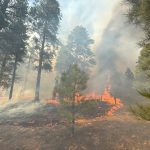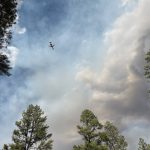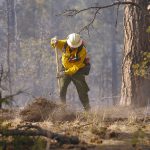
FERC’s decision wasn’t just a rejection of PPA, it was a shift in policy
By Denis Payre
Editor’s note: Denis Payre is the president and CEO of Nature and People First.
We are developers specializing in Pumped Storage Hydropower (PSH) projects, a well-proven technology for energy storage with roots dating back a century.
PSH utilizes two reservoirs of water situated at different elevations, connected by a conduit, operating within a closed-loop system. During periods of abundant energy, such as midday solar peaks, water is pumped from the lower reservoir to the upper one. Conversely, during peak consumption times and nighttime when solar energy isn’t available, water is released to drive turbines. This process enables the recovery of approximately 80% of stored energy, akin to a water battery.
With the significant expansion of solar projects in the Southwest, there’s heightened demand for PSH. These projects can bring very substantial benefits to the Navajo Nation. We aim to respond to the recent decision by the Federal Energy Regulatory Commission (FERC) regarding several PHS projects we’re actively pursuing within the Navajo Nation, as FERC oversees the permitting process for these projects.
First, FERC’s decision wasn’t just a rejection of our Preliminary Permit Application (PPA). It was a shift in policy by FERC that invalidates all Preliminary Permit Applications submitted on Tribal Land up to this point if they have not been explicitly supported by the tribal land. Two other Preliminary Permit Applications in the Navajo Nation from another company were rejected as well. FERC now requires tribal land involvement in authorizing these applications before they’re submitted, a requirement that wasn’t in place previously. As a reminder, a PPA should not be misconstrued as a permit to commence construction; rather, it grants permission to explore the feasibility of a designated project. A PPA initiates a span of three to four years dedicated to conducting exhaustive feasibility studies to ensure the project aligns with the regulations stipulated by various Navajo Nation and federal agencies.
While we comprehend the legal reasoning behind the change of rule by FERC which is to align with a new practice at the federal level, it is undeniably disheartening to receive this retroactive decision. Our expectation was that projects already filed under a specific rule would continue to be governed by that rule, with changes applying only to new filings. Over four years, we dedicated ourselves to these projects, investing significantly in good faith under a clear rule that has now been abruptly altered.
We started working on projects in the Navajo Nation in 2019, and our oldest FERC PPA’s were filed in October 2021 after extensive consultations with key local stakeholders. Our commitment to combating climate change, a responsibility we believe falls upon our generation, fuels our endeavors. However, this setback in such a historic and crucial battle may not only impede our progress but also dampen the spirits of some team members and investors. Developing pumped storage projects is inherently challenging; this additional obstacle threatens to halt our collective efforts. We advocate for a streamlined process for projects affected by this decision upon resubmission.
This change of rules for Preliminary Permit Applications with FERC is also clearly the result of actions conducted by NGOs opposing our projects. I will not comment on the actions of these NGOs but only clarify two key points for the record.
Firstly, it is important to correct any inaccuracies regarding our consultations with the Navajo Nation prior to submitting our initial Preliminary Permit Applications to FERC. Our engagement with the Navajo Nation commenced as early as September 2019, well before the filing of our applications. During this period, we had the privilege of presenting our plans for developing Pumped Hydroelectric Storage projects to several significant stakeholders within the Navajo Nation. These engagements included meetings with esteemed decision-makers such as the speaker of the Council at the time, the Navajo Nation Council, the Navajo Nation Division of Economic Development, and representatives from the Department of Justice responsible for water rights management. Additionally, we engaged with various local communities, notably the leadership of the Chilchinbeto Chapter. It’s essential to note that our initial Preliminary Permit Applications were submitted to FERC in October 2021, more than two years following these initial consultations.
Secondly, I want to reiterate a point that has been consistently communicated both verbally and in written form during our interactions with NGOs, as well as being outlined in our communication – and in particular – on our website. The rationale behind delineating large areas in our Preliminary Permit Applications was to provide the chapters and the Navajo Nation with a wide array of options for potential project locations. Our intention was to ensure flexibility in site selection and to maximize the opportunities available to accommodate the needs and preferences of the communities involved.
Furthermore, we took into consideration whether grazing right permittees would express interest in participating in these projects. Additionally, we aimed to provide our engineers with flexibility regarding project locations, considering various technical constraints such as geotechnical data, biodiversity concerns, and the preservation of cultural artifacts. It was imperative for us to ensure that our project plans were not only feasible but also aligned with environmental and cultural preservation efforts while accommodating the needs and preferences of all stakeholders involved.
The final scale of our actual projects was intended to be approximately one-tenth of the size indicated in the Preliminary Permit Applications. Our reservoirs will cover a maximum surface area ranging from 200 to 300 acres. To provide perspective, an area of 200 acres is equivalent to a square with sides measuring 3,000 feet each. I trust that these clarifications underscore our ongoing commitment to transparent and inclusive dialogue with all stakeholders, particularly the Navajo Nation and local communities, as we navigate the development of our projects in a manner that prioritizes environmental sustainability and respects the interests of all involved parties.
Finally, we believe that our projects are very reasonable and highly acceptable by local communities when they are given a chance to understand what we are really intending to do beyond emotions and miscommunications. The Black Mesa East project to be located in the Chilchinbeto chapter for example, has garnered robust local support, particularly from the Western Navajo Agency Council. This support was evidenced by a favorable resolution from the agency last September, which encompasses 18 chapters within the Navajo Nation region where our project is slated to be constructed.
Regarding access to water which has been challenged by NGOs, we firmly believe that our projects will play a pivotal role in assisting the Navajo Nation in establishing water rights, particularly in a time where access to water is increasingly critical. Our initiatives are focused on tapping into the C-Aquifer, a substantial water source that has been largely underutilized by the Navajo Nation and experiences significant annual recharge. Notably, 99% of the pumping from this aquifer is carried out by communities located off the reservation.
It’s crucial to grasp that history has repeatedly demonstrated that not utilizing water resources can lead to losing access to them. The recent ruling by the Supreme Court in the case concerning the Navajo Nation’s Colorado River rights serves as another poignant example of this principle.
Water rights are established through usage. Initially, we’ll require water for the first two years to fill our reservoirs. However, due to our power plant operating in a closed loop system, the water capacity we’ll develop will far exceed our immediate needs for the next century. Merely 20% of this capacity will be utilized to mitigate evaporation, leaving the remaining 80% available to the chapters and the Navajo Nation for various needs, primarily grazing and agriculture, potentially utilizing pivot irrigation techniques.
We’re fully prepared to provide both the capital and expertise necessary to construct a significant water infrastructure that will primarily benefit the Navajo Nation in the long run. The impact of our project on the livelihoods of local communities will be profound, particularly in a context where economic development is crucial. Presently, as you certainly know the unemployment rate in the Navajo Nation stands at 48.5%, with an average household income of only $8,240.
In the Black Mesa area, we have three projects in the pipeline capable of accessing the C-Aquifer. Each project has the potential to supply up to 3,000 acre-feet of water to local communities annually, equivalent to the yearly water consumption of 270,000 Navajo citizens. Importantly, this represents only 3.57% of the annual pumping from the C-Aquifer and 1.72% of its annual recharge rate. And the Navajo Nation does not have to use the full pumping capacity.
Moreover, each project will generate 1,000 jobs over three years, along with 100 permanent direct and indirect positions. Furthermore, it will lead to improvements in access roads and bring in significant tax revenues for the Navajo Nation.
Our efforts are not solely aimed at effectively combating climate change by facilitating the integration of more solar and wind projects in the southeast. We are also effectively combating poverty, ultimately achieving our goal of prioritizing both nature and people.
The Navajo Nation isn’t condemned to perpetual poverty. The push for Pumped Hydroelectric Storage in the region presents a historic chance for the Navajo Nation to leverage its strengths and longstanding credibility in the energy sector, potentially securing a substantial market share in these emerging infrastructures. This endeavor could usher in widespread economic development, with our projects specifically opening avenues for new water rights and infrastructure, thereby creating further economic prospects. However, this window of opportunity won’t remain open indefinitely. Emotional reactions and misconceptions surrounding such projects could result in profound missed opportunities for the Navajo people, regrets that could haunt them for generations to come.








 Highway 264,
Highway 264, I-40, WB @ Winslow
I-40, WB @ Winslow